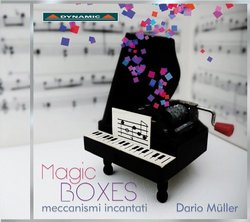| All Artists: Dario Muller Title: Magic Boxes Members Wishing: 0 Total Copies: 0 Label: Dynamic Release Date: 5/27/2014 Genres: New Age, Classical Styles: Instrumental, Symphonies Number of Discs: 1 SwapaCD Credits: 1 |
Search - Dario Muller :: Magic Boxes
 | Dario Muller Magic Boxes Genres: New Age, Classical The sound world that is disclosed by opening a music box has always fascinated musicians. One wonders why so many artists have been attracted by the ethereal appeal of these small musical mechanisms invented three-hund... more » |
Larger Image |
CD Details
Synopsis
Product Description
The sound world that is disclosed by opening a music box has always fascinated musicians. One wonders why so many artists have been attracted by the ethereal appeal of these small musical mechanisms invented three-hundred years ago; the answer, indeed, must lie in their imperceptible vibrations, their celestial sounds communicating tenderness and serenity, and evoking the reassuring atmosphere of childhood. Curiously, the sound of the carillon began instead to be imitated in works that took inspiration from fairy tales and legends, automatons, literary themes, or magical/surreal atmospheres. Various imitations of carillons were hence created through the expressive means of the piano. Among them there are simple motives (generally rêveries and berceuses) that are part of didactical collections destined for children, such as those by Alexandre Tansman, Paul Pierné, Irène Poldowski and Milo Giovanni; humorous and grotesque carillons, like those by Vittorio Rieti, Alfredo Casella, Heitor Villa-Lobos, Pierre Sancan, Rudolf Friml, Franco Margola and Enrico De Angelis-Valentini; and other pieces that reproduce the various tinkling sounds of music boxes, snuff-boxes and clocks, such as Emil Neblings Spieldose. In the classical and Biedermeier periods, clockwork musical instruments called Flötenuhr or Spieluhr made their appearance in central Europe. Consisting of a spiked drum, some wooden pipes, bellows and a clock, the Flötenuhr played a delicate and bright tune on the stroke of each hour, producing a magical atmosphere. Some musicians composed works for these mechanisms, among them Haydn and Beethoven. Our programme features four such pieces to exemplify this curious production. Also the Tic-Tac Polka from Johann Strauss operetta The Bat, here recorded in an arrangement for piano made by Otto Schulhof, is part of this musical genre, taking us back to the time of Viennas splendour.
